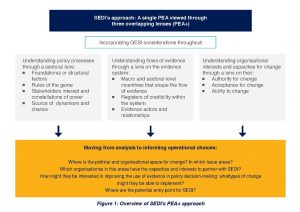
Understanding the space for change: integrating a ‘Triple A’ lens into a political economy analysis
The Strengthening the use of Evidence for Development Impact (SEDI) programme has been working in partnership with governments in Uganda, Ghana, and Pakistan to develop capacity and promote innovation in evidence-informed decision making. As a programme aiming to increase embedded and instrumental use of evidence in policy, our work requires a sound understanding of dynamics within government organisations.
Undertaking a political economy analysis of focus countries and sectors is a common practice in development projects. But our aim in SEDI’s analysis phase was to add a further layer of insight by asking: what is the space for change in the actual organisations we will work with?
Integrating an ‘Triple A’ lens into SEDI’s political economy analysis
To understand how an organisation works, we need to look at the context in which it operates and its relationships. Government agencies are part of a larger policy-making system; the agency and the wider system interact with one another and both are influenced by a complex web of relationships, institutions and individuals, as well as the macro context.
Integrating an organisational lens into SEDI’s Political Economy Analysis (PEA) methodology was an important step to understanding the external and internal contexts in which public agencies and organisations with a remit to use evidence are working.
Anchoring a PEA into more specific and concrete organisational contexts was an important way to lay foundations for SEDI’s implementation. At the end of the day, the project works with real people who are under a lot of pressure, who need to manage support for change internally and externally and also assess the reality of time and resources.
The organisational lens in the PEA process was a first step in identifying the space for government organisations to strengthen their evidence systems. Using the PDIA work by Harvard’s Building State Capability Programme, we evaluated the real possibilities for change by exploring the authority, acceptance and ability (AAA) they must use to so.
We asked: what authority in the agency exists to support reform or policy change? To what extent do those who will be affected by reform or policy change accept the need for change? What are the implications of the change and the ability or feasibility of implementing this change in terms of resources?
Lessons learned from using AAA in SEDI’s analysis
The AAA lens enabled the consortium to start a conversation about organisational dynamics and how these could affect SEDI’s work. The AAA helped us begin to consider the politics and power structures within the organisations where SEDI hoped to see change rather than only from ‘outside’ at a macro/systems level.
While the broader PEA was a large piece of analysis with a familiar methodology to many of our partners, the AAA/organisational lens required a different approach to look further within organisations and carried some particular sensitives in data collection. This was newer for many partners in the SEDI consortium.
AAA was a way of starting to link the PEA analysis to operational decisions about organisational entry points for the SEDI project and understand pathways to change. As such, it played an important role in SEDI’s adaptive approach, which seeks not only to generate valuable insights and learning about the context but to apply those to the operational practicalities of programme design and implementation.
For SEDI’s Uganda lead, the Economic Policy Research Centre (EPRC) in Uganda, the information obtained through integrating AAA into the political economy analysis was critical in determining the Ministries, Departments and Agencies (MDAs) that SEDI could collaborate with. Similarly, the Sustainable Development Policy Institution (SDPI), SEDI leads in Pakistan cited the usefulness of this approach in ultimately feeding into identifying and designing entry points and interventions across their activities.
As SEDI’s PEA methodology learning brief notes, the timeframe, depth and scope of the analysis phase overall was ambitious. Integration of the organisational lens to the PEA methodology happened alongside integration of a gender, equity and social inclusion lens, as well as a ‘evidence systems’ lens—each of which had important value to add to SEDI. However, weaving these all together into design and implementation and ensuring they didn’t feel like separate layers of analysis was a complex and time consuming task for the whole consortium.
What next?
Using the foundations laid through the analysis phase, in the inception phase of the project SEDI embarked on in-depth collaborative problem identification exercises with some of the government partners identified through the AAA lens of analysis. Learning from these diagnostic exercises, which used adapted versions of the Context Matters Framework, will be sharing over the coming months.
INASP will continue to use the AAA approach as part of our efforts to understand the links between systems level change the practical entry points to begin initiating this change in close collaboration with government partners. We are also continuously working to strengthen our adaptive and contextually informed approaches to capacity development programming. We hope our reflections from using AAA to introduce an organisational element into a PEA process can be relevant to others working to strengthen capacity development for evidence use.
Photo by Ryan Gerrard on Unsplash

 Previous Post
Previous Post Next Post
Next Post

